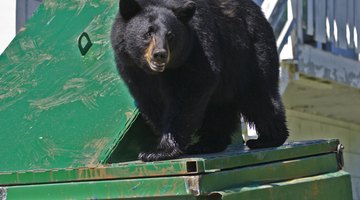How to Build a Bear-Proof Garbage Box
It isn't only campers and residents of remote communities who need bear awareness -- black bears inhabit 41 of the 50 U.S. states and all Canadian provinces except for Prince Edward Island.

If a bear is living near you, your introduction may come in the form of an overturned garbage can, and once that happens, you can expect another visit. Bear-proofing your garbage before the second visit, though, will probably prevent a third one.
Powerful Scavengers
Bears are scavengers, and they find table scraps, old pet food, food containers and even birdseed interesting. Whereas a raccoon may use wile to break into a closed trash container, a bear does it by brute force. Residents of remote communities in bear country often bear-proof their trash by storing it in containers suspended from trees or by keeping the trash in the house or in the garage, but these strategies aren't always practical. Bear-proofing a trash enclosure takes strong materials that can't be pried apart. Reinforcing a conventional plastic trash container with bungee cords may keep raccoons away, but it won't deter a bear.
Bear Enclosure Guidelines
The best bear enclosure is one that hides the trashcans, because bears are less likely to be interested in the cans if they can't see them. The enclosure needs to be impact-proof and anchored so that it won't tip over, and it shouldn't have any seams into which a bear can latch its claws. Plywood, heavy plastic and metal are suitable materials for the enclosure -- plywood should be at least 5/8 inches thick. To be strong enough to withstand a bear, the framing should be constructed with 2-by-4-inch lumber and assembled with screws -- bears can pull nails apart.
Bear-Proof Latches
To properly seal your enclosure, you should use more than one latch. The latch should fit as tightly as possible when the door is closed. Even if it does, though, a bear may be able to get its claws underneath it, so don't rely on screws to prevent the bear from prying off the hasp or the eyehook -- bolt them to the enclosure. Secure the hasp to the eyehook with a padlock or a spring-loaded clip. If you make your enclosure from rigid plastic, reinforce the latches with metal mending plates to prevent the bear from ripping the latch through the plastic.
Modifying Your Garbage Container
If you live in a community with trash disposal service, you may be required to use a bear-resistant garbage container provided by the service, or to obtain or create one. Although it's easy for a bear to tip a conventional trash container, the container is strong enough to keep the bear out if you adequately lock the lid. You can do this by bolting hasp and eyebolts to the container, reinforcing them with mending plates to prevent the plastic from ripping. Be sure that the lid fits tightly when the container is locked so a bear can't get its claws underneath it.
The Drip Cap
- It isn't only campers and residents of remote communities who need bear awareness -- black bears inhabit 41 of the 50 U.S.
- states and all Canadian provinces except for Prince Edward Island.
- Bears are scavengers, and they find table scraps, old pet food, food containers and even birdseed interesting.
- The best bear enclosure is one that hides the trashcans, because bears are less likely to be interested in the cans if they can't see them.
- To properly seal your enclosure, you should use more than one latch.
- Even if it does, though, a bear may be able to get its claws underneath it, so don't rely on screws to prevent the bear from prying off the hasp or the eyehook -- bolt them to the enclosure.
References
Writer Bio
Chris Deziel has a bachelor's degree in physics and a master's degree in humanities. Besides having an abiding interest in popular science, Deziel has been active in the building and home design trades since 1975. As a landscape builder, he helped establish two gardening companies.
Photo Credits
- Suzann Julien/iStock/Getty Images
- Suzann Julien/iStock/Getty Images
More Articles


